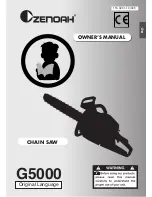
- 12 -
ASSEMBLING
1. ASSEMBLING THE BAR AND CHAIN (Fig. C)
!
IMPORTANT! Installation must be carried out with
absolute precision. Incorrect assembly causes danger.
Before proceeding, carefully examine the tool’s components
and all figures. If you are not familiar with handling and
assembling mechanical components, we recommend that
you contact an authorised service centre.
- Wear protective gloves.
- Submerge the chain (pos. 14) in lubricant oil (not included)
and let it soak for a few hours; then dry the chain with a
cloth, leaving a thin layer of oil.
- Place the machine on a flat surface and remove the casing
(11) by unscrewing the handwheel (19).
- Insert the chain (14) around the bar (13) taking care to
respect the correct direction of direction of the cutting
edge.
- Pass the chain around the gear wheel (16) and position
the bar over the hole of the threaded pin (18).
- Pull the bar to the right to slightly tension the chain.
- Mount the casing (11) by turning the handwheel (19) but
fasten it only slightly.
- Turn the tension ring nut (20) so that the chain tightening
pin (25) is aligned with the lower hole of the bar (21)
- Screw the handwheel (19) by inserting the peg (25) on
the hole (21) leaving a couple of turns before complete
fixing.
- Turn the ring nut (20) anticlockwise to hold the chain (see
chapter on chain tensioning)
- Fasten the crankcase by turning the handwheel (19) to the
end stop.
WARNING! Do not use the machine before having ten-
sioned the chain.
2 CHAIN TENSION (Fig.C)
- Loosen the fixing handwheel (19) one turn.
- Turn the chain tightening ring nut (20) anticlockwise
until the correct tension is reached. The chain tension
is correct when you can manually lift 3-4 mm from the
center of the bar.
- If the chain is too tight, turn the chain tightening ring nut
(20) slightly clockwise to release the tension
- When the adjustment is complete, tighten the central han-
dwheel (19) securely (do not use pliers or tools).
- Repeat the check for correct tension.
- When starting for the first time, lubricate the bar chain and
rail with specific oil.
WARNING! The chain tension must be checked every
time work is started, after the first cuts and regularly
every 10 minutes.
WARNING! During the first cuts, when the machine is
still new, the chain will loosen quite frequently, but this
is normal during the break-in period.
WARNING! Never leave the chain loose because it can
come out of the bar while you are cutting.
Do not overstretch the chain because the lubrication system
may not work properly.
WARNING! Don’t start! It is forbidden to operate the
tool without lubricating oil for the chain (see following
chapter).
3 FILLING THE OIL TANK FOR CHAIN LUBRICATION (Fig.A)
The electric tool is supplied with the tank empty. Never start
the tool if there is no oil or with the level below the minimum.
WARNING! Before filling it is important to clean with a
brush in the area of the cap, in order to eliminate dirt.
Unscrew the oil cap (pos. 10) and fill the tank with biode-
gradable chain oil (not included); do not use old or recycled
oil. Use the cruet supplied (if present) to avoid spilling oil
on the machine.
Fill the tank up to the maximum level (if there is an indicator),
or at a level of 2cm below the upper edge of the tank, taking
care not to introduce dirt, shavings or dust into it. At the end,
close the cap and clean with a rag.
WARNING! The oil level must be checked frequently during
operation, to prevent the chain from remaining without
lubricant. If the chain is operated without oil there will be
rapid wear of the chain and bar and the tool life will be
reduced. Check the oil level frequently during use.
WARNING! The autonomy with a full oil can vary depen-
ding on how much the chain has been tensioned, the type
of wood being cut, the ambient temperature, the density
of the oil and the way of use.
4. MOUNTING THE CUTTING HEAD ON THE TELESCOPIC
ROD (Fig.E)
- Couple the telescopic extension with the label ‘’motor side‘’
following the images in fig.E
5. ASSEMBLY OF THE HANDLE ON THE TELESCOPIC
ROD (Fig.F)
- Couple the telescopic extension with the label ‘’handle
side‘’ following the images in fig.F
REMOVAL OF THE CUTTING HEAD OR THE HANDLE (Fig.E-F)
To separate the telescopic rod from the motor / handle,
press with a thin screwdriver inside the release hole (26) to
compress the pin (9) and simultaneously extract the tube.
ATTACHING THE POWER EXTENSION (Fig.G)
Attach the power extension (not included) as shown in fig.
G and insert the plug into the socket.
STARTING AND STOPPING (FIG.A)
!
IMPORTANT! Before switching on the power tool it is
mandatory to wear personal protective equipment (not
included) listed in the chapter Warnings.
!
IMPORTANT! Make sure nobody is approaching the
working area during use.
Switching on
1. Grip both handles firmly (pos. 2-5)
2. To start, in sequence press the release button (pos. 4)
and then press the switch (pos. 3).
The switch is a ‘maintained action’ switch so the electrical
tool will stay on when you keep the switch pressed.
Switching off
1. To switch off, release the switch (pos. 3) and the release
button (pos.4), holding the tool firmly.
We recommend repeating these operations several times
before starting work, in order to familiarise yourself with
the controls as much as possible.
If you notice any working defects, switch off the power tool
and consult the chapter “Problems, causes and solutions”.






























